Felixstowe: Difference between revisions
Created page with '{{Infobox town |name=Felixstowe |county=Suffolk |picture=The end of the docks - geograph.org.uk - 982178.jpg |picture caption=Felixstowe seafront and docks beyond |os grid ref=TM…' |
No edit summary |
||
| Line 80: | Line 80: | ||
Felixstowe is Britain's largest container port. | Felixstowe is Britain's largest container port. | ||
The main navigation channel is dredged to 14.5 metres below chart datum, and a depth of up to 15 metres alongside the quay, Felixstowe boasts deep-water able to accommodate the world’s latest generation of deep-draughted ultra post-Panamax vessels. There is a continuous quay of | The main navigation channel is dredged to 14.5 metres below chart datum, and a depth of up to 15 metres alongside the quay, Felixstowe boasts deep-water able to accommodate the world’s latest generation of deep-draughted ultra post-Panamax vessels. There is a continuous quay of about a mile and half, equipped with 25 ship-to shore gantry cranes. | ||
It has congested road links to the [[Midlands]] by way of the A14 and to [[London]] by the A12. The single-track railway line to [[Ipswich]] has recently been upgraded to allow larger containers, and many containers are now transported by rail. | It has congested road links to the [[Midlands]] by way of the A14 and to [[London]] by the A12. The single-track railway line to [[Ipswich]] has recently been upgraded to allow larger containers, and many containers are now transported by rail. | ||
Latest revision as of 10:57, 5 August 2015
| Felixstowe | |
| Suffolk | |
|---|---|
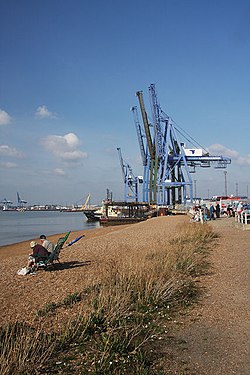 Felixstowe seafront and docks beyond | |
| Location | |
| Grid reference: | TM306345 |
| Location: | 51°57’40"N, 1°21’27"E |
| Data | |
| Population: | 29,349 (2001) |
| Post town: | Felixstowe |
| Postcode: | IP11 |
| Dialling code: | 01394 |
| Local Government | |
| Council: | East Suffolk |
| Parliamentary constituency: |
Suffolk Coastal |
Felixstowe in Suffolk is a substantial container port and also seaside resort town on the North Sea coast. The Port of Felixstowe is the largest container port in the United Kingdom. [1] The town stands across the estuary of the River Orwell and the River Stour from Harwich in Essex.
History
A village has stood on the site since long before the Norman conquest The early history of Felixstowe, including its Roman, Anglo-Saxon, Norman and mediæval defences, is told under the name of Walton, because the name Felixstowe was given only during the 13th century. Walton remains the distinct town centre a little inland.
Felixstowe continued as a linchpin in England's defence, as proved when in 1667 Dutch soldiers landed near the Fludyers area and failed to capture Landguard Fort. The town only became a major port in 1886. In addition to shipping, tourism increased, and a pier was constructed in 1905 but is now unsafe. Indeed, during the late Victorian period (after circa 1880) it became a fashionable resort, a trend initiated by the opening of Felixstowe railway station, the pier, (see above) and a visit by the German imperial family. It remained so until the late 1930s. In 1953, at least 48 people died in the town in the North Sea flood.
Landguard Fort
Landguard Fort stands on the site of the last opposed invasion of England in 1667 and the first land battle of The Duke of York and Albany's Marines. The current fort was built in the 18th century, and modified in the 19th century with substantial additional 19th/20th century outside batteries. The fort hosts regular military re-enactments, including Darell's day with a Sealed Knot celebration of the last invasion, art exhibitions and alternative theatre. Landguard Fort is in the care of English Heritage and managed by the Landguard Fort Trust.
Felixstowe Museum
A museum telling the story of Felixstowe, with a reference library, historic maps, photo archive and 14 rooms of artefacts from Roman finds, the Martello towers, military social and domestic history through two world wars and into the new millennium is managed by volunteers from the Felixstowe History and Museum Society. It is located in the old submarine mining establishment building at Landguard Point, between the Fort and Port.
Pier
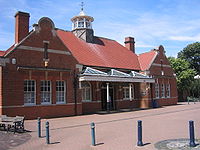
During the Second World War the majority of the pier, at the time one of the longest in the country and complete with its own train, was purposely demolished by Royal Engineers to prevent it being used as an easy landing point for enemy troops. Unfortunately after the war the damage was never repaired and the pier never regained its original length. Felixstowe was also one of the few places bombed by the Italians during the Blitz. Benito Mussolini's airforce proved to be no match for the Royal Air Force, who shot down a fair number of Italian biplanes over the English Channel and around Felixstowe itself.
By the late 1990s the pier had been neglected so badly that it was deemed to be unsafe and closed to the public. Plans have been presented from time to time since the closure of the pier for its redevelopment along with large disused areas of the seafront near the former site of the Felixstowe Beach railway station, but nothing has come of them.
Railway stations
The sole remaining passenger railway station, known as Felixstowe Town, opened in 1898 in the well-preserved building which now houses a Co-Operative supermarket, locally known as "Solar". It also houses other shops, including a pub, 'Play 'n' Exchange' game and joke Shop, 'Adam and Eve' hairdressers and Felixstowe Music, which is run by Felixstowe Radio, the local community radio station.
In its prime the railway station saw more than 20 services an hour, but now hosts only one, the service to Ipswich. The station now has only one platform, which has been created from the far end of one of the original platforms.
Felixstowe Beach railway station was demolished in 2004 despite a storm of protest from many local people keen on saving the 137 year-old historical building which the council had branded as 'unsafe'. The station was originally opened in 1877 and was used continuously until 1959, after which it was the site of a small printers for many years until its demolition.[2]
From 1877 until 1951 there was also Felixstowe Pier railway station sited inside the area of the modern day docks at a small pier popular with pleasure boats, and paddle steamer link to London. A dock next to the pier was approved in 1879.[3]
The docks are also served by the railway.
Landmarks
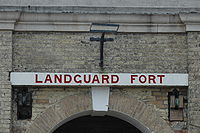
Landguard Fort is a scheduled ancient monument and visitor attraction with a nearby nature reserve. At the opposite end of the town is Felixstowe Ferry Golf Club which is amongst the oldest in the UK, having been established in 1881. The Rt. Hon. Arthur Balfour, Captain of the Golf Club in 1889, became Captain of the The Royal and Ancient Golf Club of St Andrews in 1894 and Prime Minister (in succession to his Uncle, Lord Salisbury) from 1902–1908.
Felixstowe has a recently refurbished sandy beach south from the pier, and a stoney beach north of the pier. A Victorian promenade runs along part of the beach, from the nature reserve in the southwest to Cobbolds Point (Maybush Lane in east), with traditional beach huts along most of that length. An amusement arcade with snooker halls and food outlets occupy the southern end. The pier, now disused except for a cafe and amusement arcade, stands before a leisure centre, with swimming pool, owned by the local council, now managed by a contractor.
From Brackenberry fort to Felixstowe Ferry there is a walkway and is the start of the 50 mile Suffolk Coast Path. There is no path between Cobbolds Point and Brackenberry fort as the coastal protection work now prevents pedestrian access along the beach. At low tide from Jacob's Ladder it is possible to glimpse the seaweed-covered remains of a Roman fort.
In the very centre of the town is South Beach Mansion now in private ownership. Originally built by the Eley family (famous for the Eley cartridges); town wits called it Eley Cathedral. It then passed to the Tollemache family and was at one time owned by the King of Portugal. It was also here that Kaiser Wilhelm II of Germany and his family came to stay in 1893 putting Felixstowe on the international social map. During the war it was an army headquarters before becoming the Felixstowe Town Hall.
Perhaps the most striking building on the front is Harvest House. Originally built as the Felix Hotel it then became Fisons's headquarters. Now it is a home for the elderly.
Sport
Felixstowe Rugby Football Union Club is the premier (and only) rugby club in Felixstowe. It was founded in 1930, and plays in the Eastern Counties Leagues. A.W. Brown, Chris Barbour, Steve Edwards, Steve Britchfield, Gareth Carr, Gavin "Boom Boom" Wright have played for the team.
Felixstowe Hockey Club has three men's teams and one ladies' team. The men's 1st team play in eastern league division 1.
The town's only senior football team, Felixstowe & Walton United, compete in the Eastern Counties League Premier Division.
The town has a sports centre, the Brackenbury, in High Road East, and football, hockey and rugby pitches, together with four bowling greens and other sporting facilities. The sports centre, owned by the council, is managed by a contractor.
Felixstowe Golf Club is a links course to the northeast of the town centre.
Leisure facilities
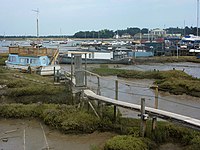
The town has two main leisure facilities: the Brackenbury Sports Centre in Old Felixstowe and the Felixstowe Leisure Centre adjacent to the pier. There is a bowls club and a tennis club has hosted a large post-Wimbledon tournament. There is also a small community centre, run by the Old Felixstowe Community Association (OFCA), in Ferry Road.
The library was refurbished in 2006 at a cost of £1,500,000 and has since won national awards.[4]
The Spa Pavilion Theatre is a 900-seat art deco-style building on the promenade, owned by the district council and managed by a private contractor; Status Quo played there in the 1970s; Jimi Hendrix, the Who, Led Zeppelin, Showaddywaddy, Slade and Mungo Jerry all played at the old Pier Pavilion which was demolished and is now the leisure centre. There is also a Sunday market that is larger than that at nearby Ipswich.
The Port of Felixstowe
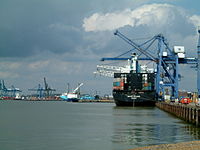
Felixstowe is Britain's largest container port.
The main navigation channel is dredged to 14.5 metres below chart datum, and a depth of up to 15 metres alongside the quay, Felixstowe boasts deep-water able to accommodate the world’s latest generation of deep-draughted ultra post-Panamax vessels. There is a continuous quay of about a mile and half, equipped with 25 ship-to shore gantry cranes.
It has congested road links to the Midlands by way of the A14 and to London by the A12. The single-track railway line to Ipswich has recently been upgraded to allow larger containers, and many containers are now transported by rail.
The port is owned by Hutchison Whampoa Ltd[5] with additional land on the peninsula owned by Trinity College, Cambridge.[6]
The port has its own Police Authority, which also currently has jurisdiction over the area local to the port (with permission from Suffolk Constabulary's Chief Inspector). Alongside the Port Police, they also have their own joint ambulance & fire service. One of the port ambulances, call sign 'Alpha 1', can also come off port to attend 999 emergencies in Felixstowe.
Outside links
- Felixstowe Town Council
- Felixstowe Museum
- Landguard Fort
- Felixstowe Radio
- [1] Photos of Felixstowe
References
- ↑ The Ports Industry in England and Wales (2006-07)
- ↑ Felixstowe Beach Station Destroyed
- ↑ "FELIXSTOWE RAILWAY AND DOCK BILL". Hansard. http://hansard.millbanksystems.com/commons/1886/mar/11/second-reading. Retrieved 2010-01-25.
- ↑ The Chartered Institute of Librarians and Information Professionals (CILIP)
- ↑ Port of Felixstowe. "Brief History". http://www.portoffelixstowe.co.uk/publications/journal/frmhistory1976.aspx.
- ↑ "Cambridge University's Trinity College in £20million bid to buy the O2 arena". Daily Mail. August 3, 2009. http://www.dailymail.co.uk/news/article-1203903/Cambridge-Universitys-Trinity-College-20million-bid-buy-02-arena.html.